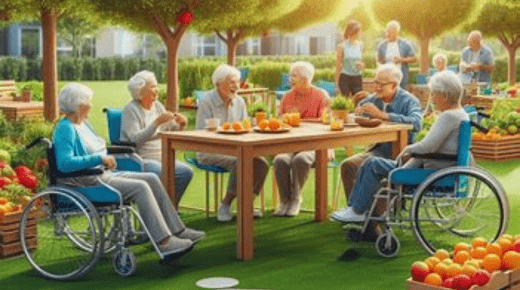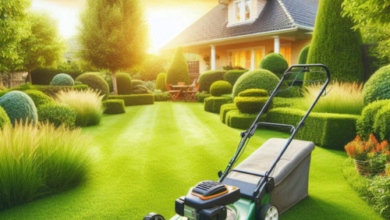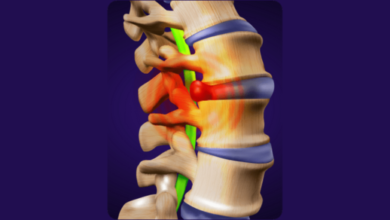Inclusive Outdoor Spaces for Seniors – Promoting Independence and Socialization

- Design outdoor spaces that prioritize safety and accessibility for seniors.
- Include features that encourage physical activity and social engagement.
- Use research-backed strategies to enhance the well-being of seniors through outdoor environments.
The Importance of Outdoor Spaces for Seniors
Outdoor spaces play a crucial role in seniors’ physical and mental well-being. Not only do they provide an opportunity for fresh air and sunshine, but they also offer a venue for social interaction and physical activity. Studies have shown that regular exposure to nature can boost spirits, lessen tension, and even improve cognitive abilities in elderly individuals. It is essential in a society where isolation is a growing concern among older people. Creating accessible outdoor settings can provide significant health benefits and enhance overall quality of life. For more information on designing such spaces effectively, click to discover more.
Designing Safe and Accessible Outdoor Areas
When designing outdoor spaces for seniors, safety and accessibility should be the top priorities. These aspects are necessary to avoid disuse of the space or dangerous accidents. Here are some key considerations to keep in mind:
- Non-slip surfaces: Ensure walkways and patios have non-slip surfaces to prevent falls. It could include textured concrete, rubber mats, or other slip-resistant materials.
- Handrails and ramps: Install handrails and ramps to assist those with mobility issues. These are particularly important for transitions between different levels of the garden or patio areas.
- Adequate lighting: Good lighting is crucial to avoid mishaps, particularly at night. Use well-distributed, glare-free lighting to ensure all areas are illuminated uniformly.
- Clear pathways: Keep pathways clear of obstacles and wide enough to accommodate wheelchairs or walkers.
Encouraging Physical Activity
Exercise is crucial for older adults to preserve their health and ability to move. Consistent physical activity can boost heart health, build muscle strength, and increase flexibility, lowering the chances of experiencing falls and other accidents. Incorporate features in the outdoor spaces that promote movement, such as:
- Walking paths: Create clear, unobstructed walking paths for daily strolls. These can be looped paths that encourage continuous walking without navigating complex routes.
- Exercise stations: Consider adding simple equipment like stretching bars or balance beams. These can accommodate different ability levels, ensuring everyone can participate.
- Gardening areas: Raised garden beds can be an excellent way for seniors to engage in light physical activity. Gardening provides physical exercise and a sense of accomplishment, which benefits mental health.
Fostering Social Engagement
Social interaction is equally essential for the well-being of seniors. Designing outdoor spaces that encourage social activities is necessary to prevent feelings of loneliness and depression that can result from isolation. Here are some ideas:
- Seating areas: Arrange seating in clusters to encourage conversation. These can be benches, picnic tables, or circles of chairs placed under a shade tree.
- Shaded patios: Provide shaded areas with comfortable seating for social gatherings. It can include pergolas, awnings, or large umbrellas that offer protection from the sun while creating cozy spots to relax.
- Community gardens: Community gardening projects can foster community and provide a rewarding group activity.
- Activity areas: Design areas that can host events such as yoga classes, book clubs, or game sessions.
Utilizing Technology for Enhanced Safety
Technology can significantly enhance the safety and usability of outdoor spaces for seniors. Implementing the following technological features can provide peace of mind for both residents and their families:
- Emergency call buttons: Install emergency call buttons in easily accessible locations. These can be linked to on-site medical personnel or emergency services, ensuring help is available at the push of a button.
- Surveillance cameras: Cameras can help monitor and ensure the safety of the outdoor area. They can be used to oversee the entire space and can be beneficial in preventing and quickly responding to accidents or incidents.
- GPS tracking: GPS tracking devices can be helpful for those with memory issues who may wander. They allow caregivers to promptly locate a resident if they leave the designated safe area.
Conclusion: Enhancing Senior Living Through Thoughtful Design
Outdoor spaces that are thoughtfully designed for seniors can significantly enhance their quality of life. By prioritizing safety, encouraging physical activity, and fostering social engagement, we can create environments that meet the needs of older adults and enrich their daily lives. As communities evolve, the importance of inclusive outdoor spaces becomes increasingly apparent.





